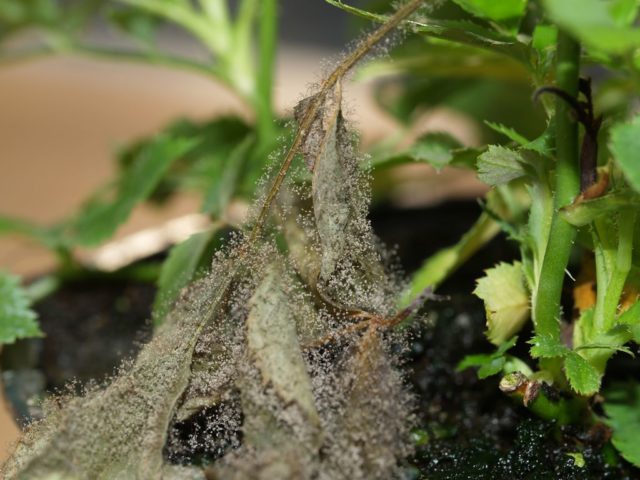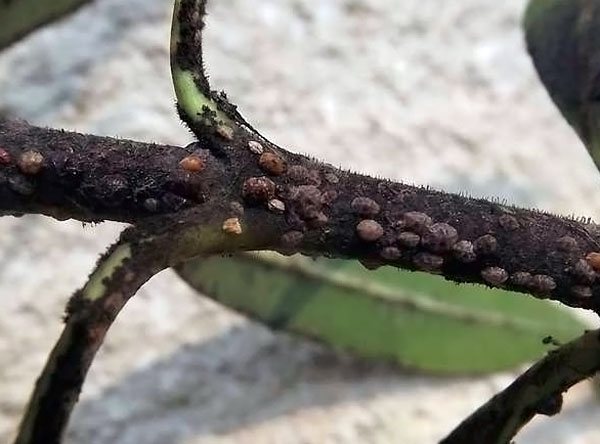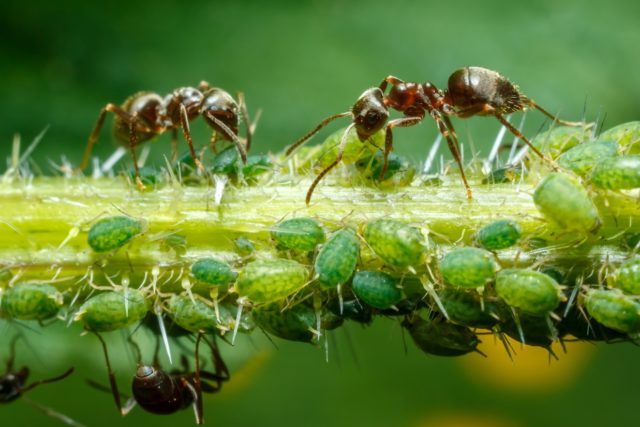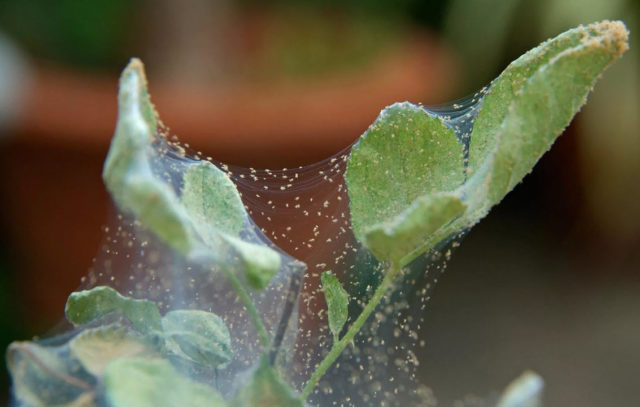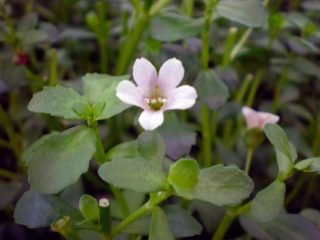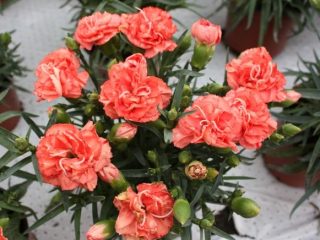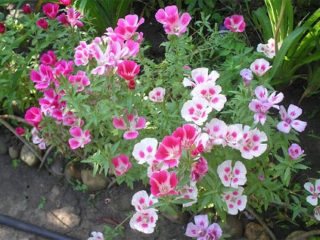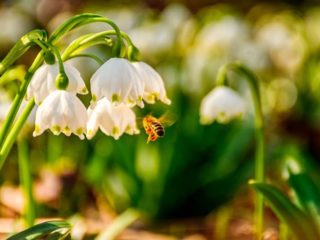Content
Ampelny Bacopa, or Sutera, is a gallant perennial flower of the Plantain family, which grows in its natural environment from the tropical and subtropical swamps of Australia, Africa, America and Asia. The plant is a low ornamental bush with a dense "head" of foliage and inflorescences, with a wide base. The flowering of ampelous varieties of Bacopa lasts in waves, throughout the summer period: flowers bloom and fade; the plant sheds its color and, after a short lull, begins to bloom again. Modern landscape designers prefer ampelous varieties of bakopa in the author's design of balconies, terraces, flower beds, flower beds, mixborders.
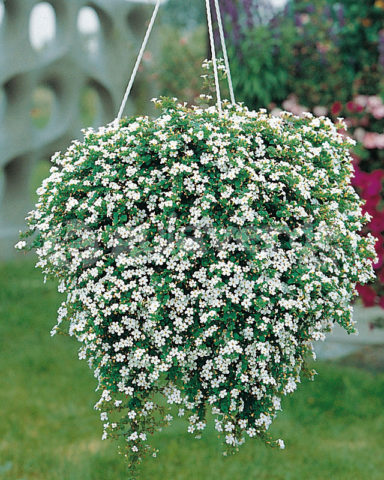
The most common is the white color of suter inflorescences, which the British call "snow flakes" for abundant flowering
Description
During flowering, ampelous terry bacopa is painted in white, blue, purple, pink shades. A species that grows in width has the following characteristics:
- superficial root system;
- thin, lodging, creeping, widening stems 0.7-1 m long;
- small, alternate leaves with a linear arrangement;
- the shape of the leaves is ovoid, broadly elliptical, with a serrated edge;
- leaf color - green or olive green;
- the shape of the inflorescences is bell-shaped with five petals.
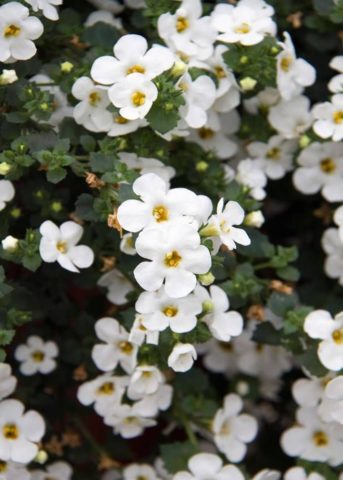
An amazing feature of the suter flowers is the fact that the inflorescences close at night.
Growing from seeds: when to sow ampelous bacopa
The seeds of the ampelous varieties of Bacopa can be planted on seedlings. Planting seeds of ampelous bacopa for seedlings is carried out in March. The growing season of plants takes quite a long time, this explains the early sowing work. For an earlier flowering of Bacopa, you can sow seedlings in February, provided additional artificial lighting is provided.
When growing flowers, suters from purchased seeds, which are produced in the form of pills with a few smallest grains, should follow the strict rule of constant moistening of the soil with crops. If you allow even a slight drying out during the germination period, the pelleting shell will harden.
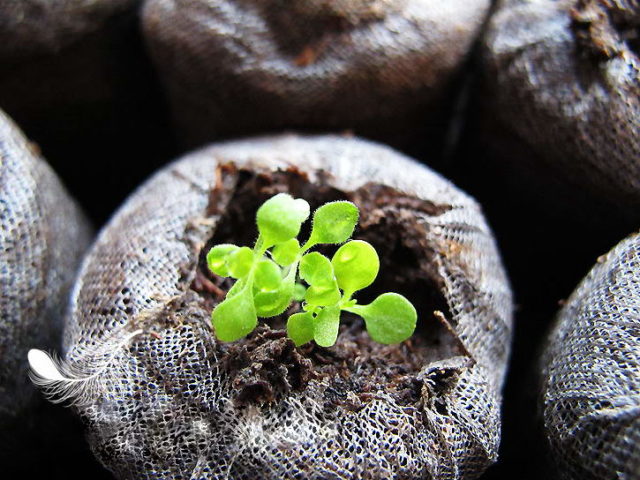
If the soil mixture is insufficiently moistened when germinating seedlings from purchased seeds, the sprouts will not be able to penetrate the hard shell of dragee-capsules
Planting and care at home
Planting seedlings of bakopa flowers at home is not distinguished by complex manipulations. You should correctly choose the capacity, soil composition, ensure the correct microclimate, watering, feeding and pruning.
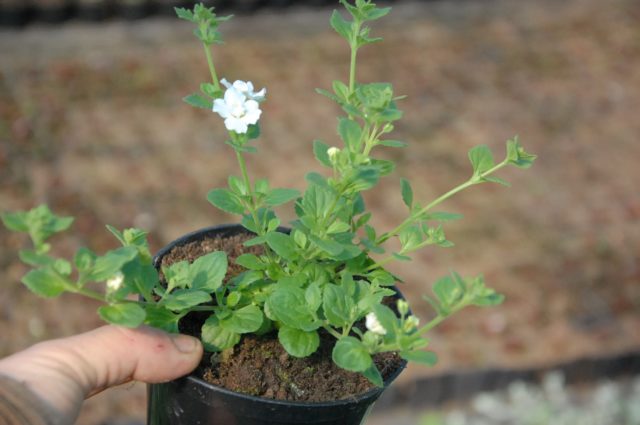
Suter seeds remain viable for 2-3 years
Sowing
Sowing seeds of ampelous varieties of Bacopa can be complicated by the fine structure of the grains. There are no special requirements for the choice of container for seedlings. It can be a wooden, plastic container.
The grains of the tropical culture of Bacopa in the form of capsules are evenly distributed over the surface of the container, slightly pressing into a well-moistened soil, without covering the seeds. The crops are moistened with water from a spray bottle and then covered with foil or glass to create a greenhouse effect.
After 2-3 weeks, the first shoots appear.As the Bacopa seedlings grow, the flowers gradually accustom themselves to the lack of shelter, so that the young shoots “learn” to live in a less humid environment.
When the first 2-3 leaves appear, the bacopa dive for the first time into large containers along with a lump of earth so as not to injure the root system. At the first pick, it is necessary to observe a distance of 2 cm between individual bacopa shoots and apply a surface planting method without deepening the roots.
When the young shoots have grown noticeably, it is necessary to move the bacopa bushes into separate pots with good drainage. This is the second pick, during which the plant is buried in the ground by 1 knot.
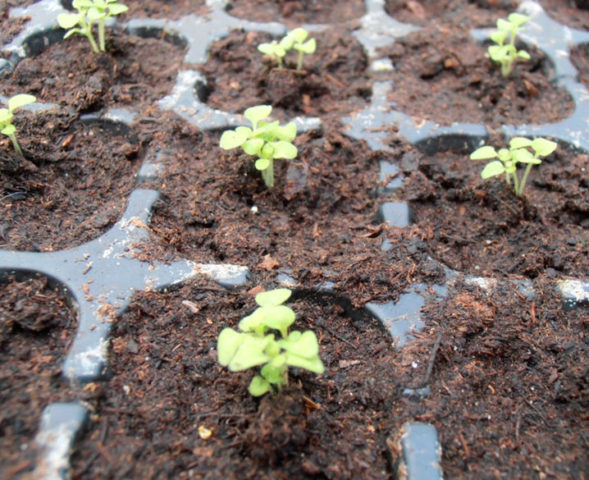
1 g of seed material of Bacopa flowers can contain up to 5000 seeds
Shine
To place a container with crops of ampelous bacopa flowers, you should choose bright places with a sufficient amount of natural daylight. When sowing flowers of suters for seedlings at the end of winter, it is necessary to additionally illuminate the sprouts. The optimum temperature for the growth and development of tropical seedlings is + 20-23 ⁰С.
After the first pick, for effective growth of bacopa shoots, a special temperature regime of + 23-26 ⁰С is required.
After the second pick, Bacopa seedlings are read to gradually "accustom" to development at lower temperatures of + 15-23 ⁰С.
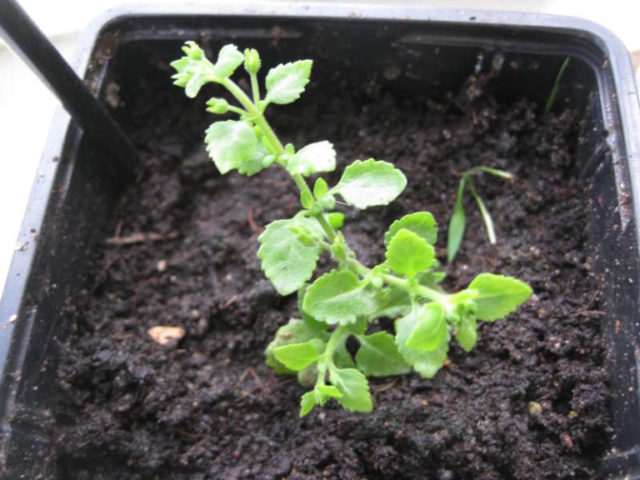
With sufficient lighting, the first shoots of suter flowers appear after 2 weeks
Priming
For sowing seedlings of Bacopa flowers, you should choose a moisture-permeable, air-permeable, loose soil with a low percentage of acidity. You can prepare the soil yourself:
- humus (2 parts);
- peat (1 part);
- sheet land (1 part);
- river sand (part 2).
Experienced flower growers note that it is more effective to sow suter seeds into a ready-made peat substrate or peat tablets, which must be constantly and especially carefully moistened.

Some growers recommend using well-moistened compost for germinating the seeds of the suter.
Fertilizers
After the first picking of seedlings, the tropical culture is ready for feeding. To fertilize bakopa seedlings at this stage, it is best to choose complex mineral fertilizers.
After the second picking of seedlings into separate pots or containers for the culture, it is necessary to fertilize with nitrogen- or phosphorus-containing preparations.
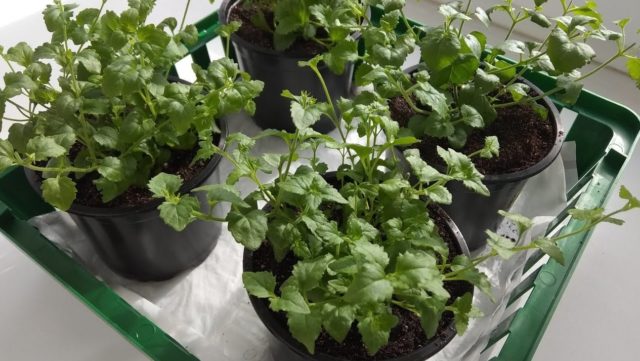
When feeding ampelous varieties of bacopa, half the dose is used than for other crops
Watering and humidity
To ensure the rapid growth of seedlings, it is necessary to create greenhouse conditions with a high level of humidity for crops of ampelous suter.
Due to the fact that the plant belongs to aquatic, moisture-loving crops, the shoots of the suter require careful but abundant watering.
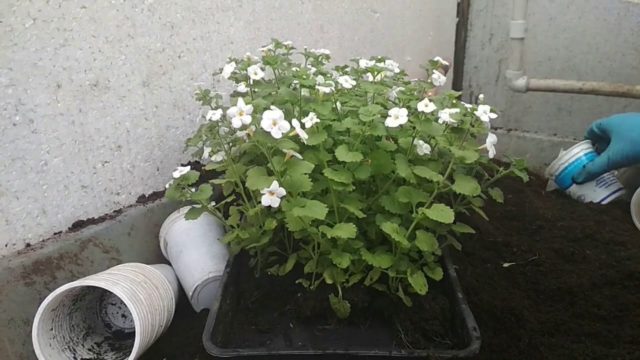
It is best to water the Bacopa seedlings daily using a spray bottle.
Pruning
Seedlings of ampelous varieties of suters require simple maintenance. In order for the flowers to bush beautifully, it is necessary to cut or pinch the shoots. Pruning is carried out when individual stems along the entire length reach a size of 10 cm.
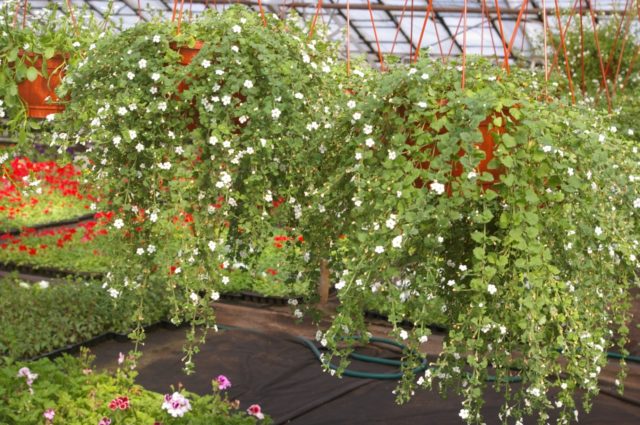
The ampelous suter bush will be more lush and decorative if you cut off long lashes
Planting and caring for the garden
Experienced growers recommend planting ampelous bacopa in hanging pots or pots for several bushes (2-3 plants in one container, up to 5 liters). In addition to hanging structures, you can plant suter flowers:
- in floor pots, pots, containers, boxes;
- in wicker baskets;
- near a pond or fountain;
- on the garden bed as a ground cover crop next to dahlias, chrysanthemums or roses;
- for decorating arches or terraces;
- to create the visual effect of "blooming vertical walls".
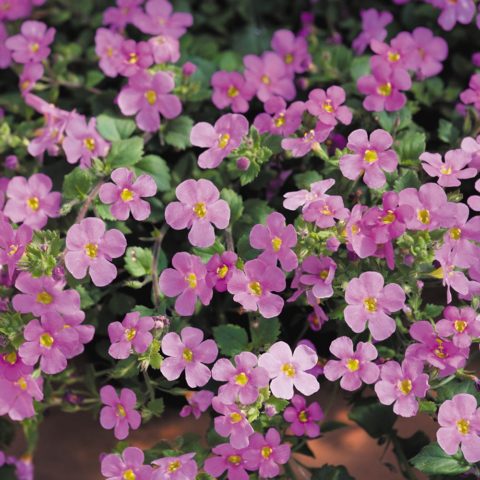
With proper care, the flowers of the sutra grow, the lashes hang down and form a decorative "cloud" of foliage with a huge number of stylish small flowers of white, pink, purple, blue shades
Where to plant
In landscape design, ampelous varieties of bacopa look spectacular on beds, in flower beds, mixborders, in decorative flowerpots, containers, boxes, baskets, pots, hanging pots. Planting plants in the open air is carried out after the establishment of stable warm weather.
The seedlings of the flowers are moved by the suters into the open ground - in the wells prepared in advance. The roots, together with a lump of earth, are carefully placed in a well-moistened hole, sprinkled and compacted. Water abundantly, at the root.
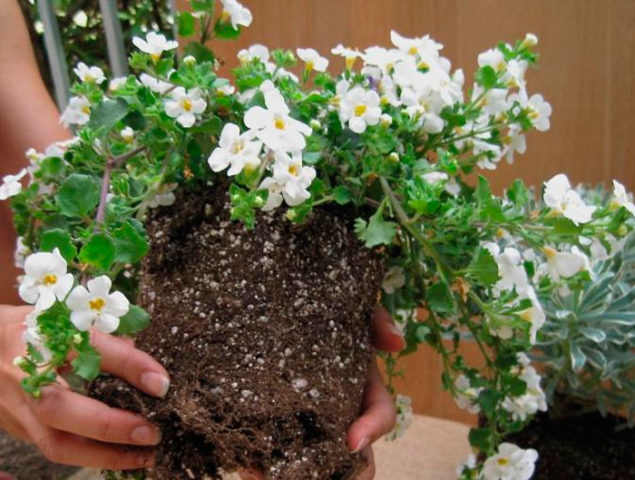
Clouds of Bacopa flowers in hanging pots look rich and stylish
Shine
For a tropical culture, places with a sufficient level of natural light are chosen. Slightly shaded areas protected from wind and drafts are also suitable. In the shade, ampelous varieties of suters will stretch out and form less attractive, leafy shoots.

Hanging pots with a sutter are not recommended to be placed in drafts
The soil
The soil for ampelous bacopa should be slightly acidic, saturated with nutrients. A prerequisite for the soil for tropical flowers is excellent water and air permeability.
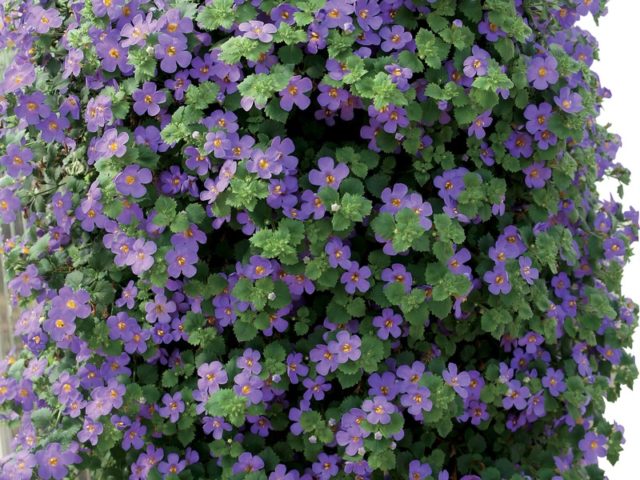
The flowers of the ampelous suter grow and develop very well in peat soil
Fertilizers
Flowers of ampelous bacopa should be fertilized after planting: in May and June. The optimal feeding period is the growth period. Bacopa "prefers" liquid complex fertilizers for flowering plants and natural organic matter. Top dressing should be done at regular intervals: once every 1-2 weeks.
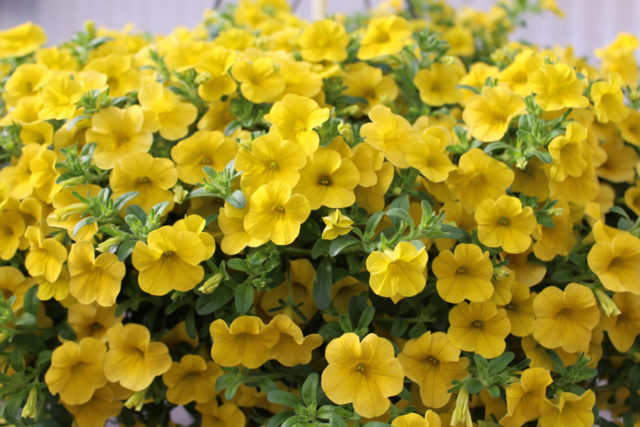
Fertilizers must be applied at the root, avoiding contact with foliage.
Watering
Since the ampelous bacopa is native to tropical swamps, sufficient water is required for growth and development. Watering should be frequent, abundant.
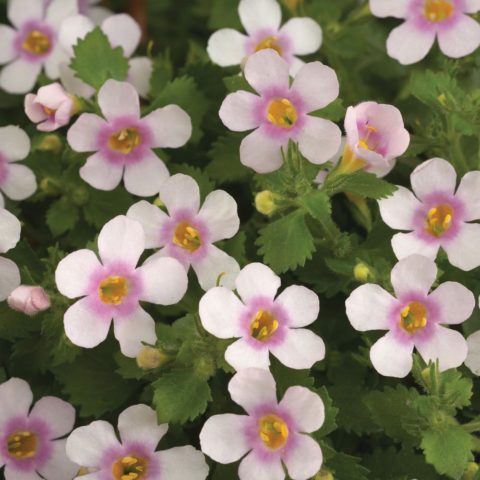
Do not allow the soil around the sutra bush to dry out
Pruning
At the beginning of the first flowering, when the ampelous bacopa bush is gaining strength, excessively long stems (more than 50-60 cm) should be cut off. Pruning will make the sutra bush more curly, lush, and give an aesthetic appearance. Symmetrical, spherical bushes of ampelous bacopa look great, which is also achieved by trimming shoots. After being “cut”, the flowers of the suters react with the rapid growth of additional central shoots.
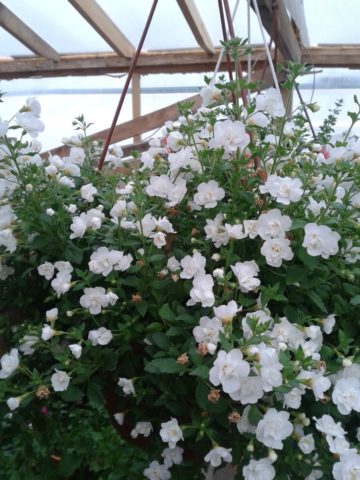
Correctly and timely cut off shoots of the ampelous suter will help create masterpieces of landscape design in the local area
Reproduction
Bacopa flowers can be propagated in two main ways:
- seeds (sowing for seedlings is carried out in January-February);
- apical processes (cuttings are made in January-April).
Photos and videos of the seed method of planting and caring for ampelous bacopa allow you to evaluate fairly simple and understandable rules that can ensure intensive growth and magnificent flowering of an exquisite tropical plant.
During vegetative propagation, cuttings of the suter (shoots up to 10 cm long with two main nodes) are rooted in moist soil. As a soil, you can choose a loose mixture based on vermiculite and sand. The cut bakopa stalk is planted in a well-moistened soil mixture to a depth of 5 mm. In this case, one healthy node should be submerged in the ground. Roots will develop from the underground node. Aboveground shoots will form from a ground node located above the ground.
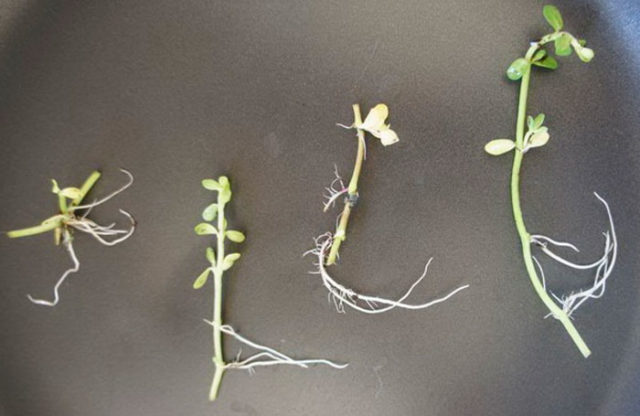
After 2-3 weeks, the cuttings of the suter flowers take root
Diseases and pests
The most popular varieties of Bacopa affect diseases such as gray rot, molds, and sooty fungi:
- Gray rot (Botrytiscinerea) appears on bacopa with ampelous brown spots on the surface of stems and foliage, which increase in size with increased air humidity. Gradually, brown necrosis is formed by a fluffy gray coating of spores and mycelium. To combat the disease, fungicidal agents, a solution of Bordeaux mixture are used.
Previously, ampelous bacopa bushes affected by gray rot were sprayed with soapy water
- Sooty fungi or "rabble" (Capnopodium) manifests itself as a black bloom in the form of tiny spores of the fungus, which clogs the pores and disrupts the metabolism in plant cells. As a treatment for bacopa ampelous disease, modern fungicides or a solution of laundry soap and copper sulfate are used.
To get rid of the sooty fungus on the flowers of the ampelous suter, it is necessary to “defeat” the aphids
Among the most common pests of Bacopa flowers are aphids, spider mites and whiteflies:
- Aphid lives on flowers of bacopa in huge colonies, all members of which mercilessly suck juices from plants, deprive them of vitality. To combat aphids, industrial insecticides or folk remedies (soap, tobacco, onion, pine infusion, essential oils) should be used.
By planting fragrant plants (dill, marigolds, lavender, mint) next to the garden bed, you can prevent the appearance of aphids
- Spider mites manifest themselves by the formation of a thin, transparent cobweb on the lower part of the leaves. Due to punctures on the stems and leaves, which the spider mite makes, the plant dries up, loses color, and gradually dies. To get rid of pests, you should spray the affected plants with soapy water.
Most often, the spider mite manifests itself after planting the bacopa in open ground, however, the cause of its appearance may be infected soil or seed
Growing difficulties
Since ampelous varieties of Bacopa flowers are of tropical origin, many European gardeners have some minor difficulties in growing a crop:
- the superficial root system of the bacopa can be damaged by careless loosening of the soil around the bush;
- you can not mulch the bacopa bushes, which can lead to rotting of the stems that spread along the surface of the earth;
- no need to pluck faded bacopa inflorescences, since the culture independently sheds the faded color;
- in order for the bacopa bush to remain curly and lush all summer long, it is necessary to cut and pinch the shoots constantly, at regular intervals;
- when the lower stems of the ampelous bacopa begin to lignify, the intensity of flowering is significantly reduced; to restore flowering, you need to cut off the stems by 1/3 and feed them.
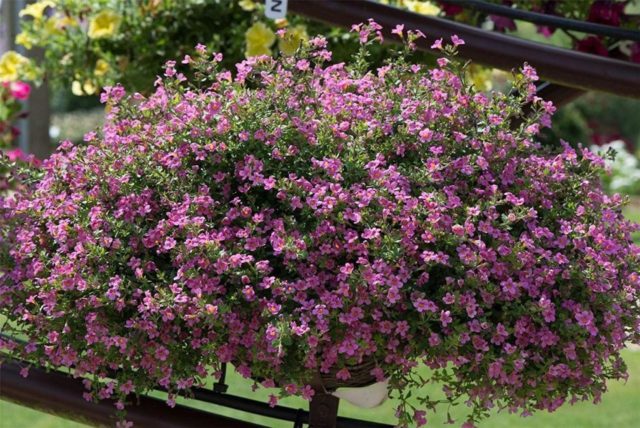
Adequate soil moisture is considered a priority in the care of ampel varieties of Bacopa flowers, since this tropical plant dies in an arid and temperate climate.
Medicinal use
For the first time, people discovered the medicinal properties of the Bacopa Monye plant or "Brahmi herb" as early as the 6th century BC.
The “golden herb” of Indian medicine (Bacopa Monnier) is characterized by a wide range of useful properties and is approved for sale as a dietary supplement (biologically active food supplement).
Medicinal characteristics of Bacopa monnieri:
- antioxidant;
- pain reliever;
- anticonvulsant;
- neuroprotective;
- nootropic;
- immunomodulatory action.
Medicinal raw materials are stems and leaves of "Brahmi Herbs" from semi-annual plants. The raw materials are dried away from direct sunlight. The extract of Brahmi shoots, Brahmi powder (from dry leaves), Brahmi oil (a mixture of decoction of leaves and base vegetable oils) are obtained on an industrial scale.
In folk medicine, Bacopa Monier flowers are used for the following ailments:
- a state of increased anxiety;
- depression;
- headaches;
- nervous disorders;
- significant mental stress;
- convulsions during epileptic seizures;
- cough, tonsillitis, frontal sinusitis, sinusitis;
- recovery after strokes, heart attacks, head injuries;
- tumors, skin ulcers.
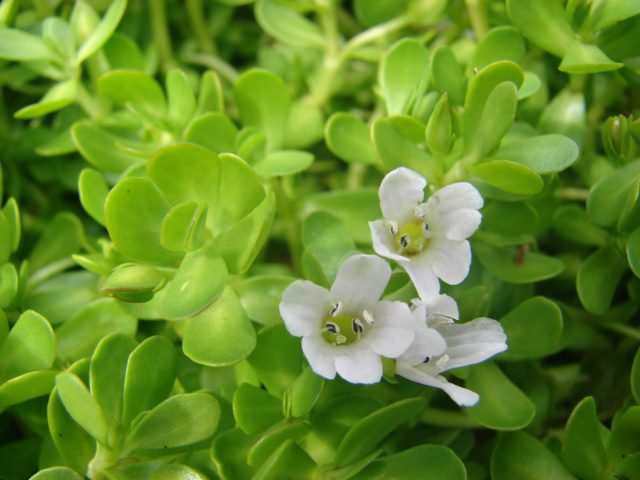
Bacopa Monnier flowers are a source of alkaloids, flavonoids, phenols, saponins, betulic acid, therefore it effectively stabilizes cerebral circulation
Photo of ampelous bacopa in the garden and interior
Delightful green foliage of ampelous bakopa flowers with small numerous inflorescences looks great in any stylistic direction of landscape design.
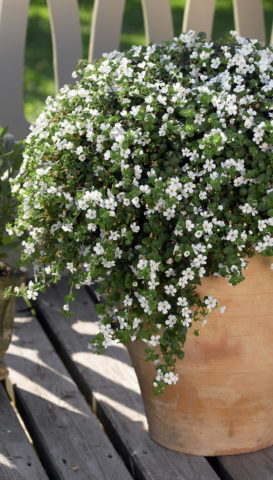
The plant is very impressive even as the only "inhabitant" of a flowerpot or hanging planter
Modern landscape designers have gone further: the lush foam of Bacopa flowers is perfectly combined in one composition with plants such as petunia, pelargonium, nasturtium or dichondra. Each culture perfectly complements the other, which makes it possible to create stylish modern solutions for interior and garden decoration.
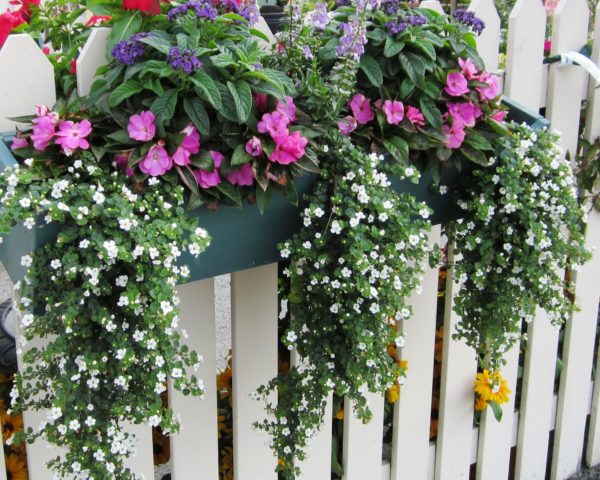
Since the line of ampelous varieties of suters is distinguished by delicate pastel shades of petals, the plants are effectively combined with bright spots of other plants.
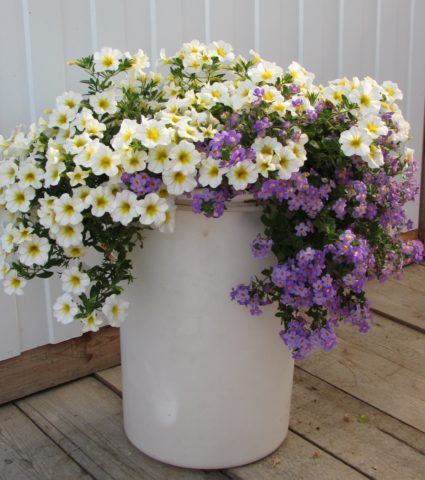
Experienced growers recommend planting bacopa flowers around the perimeter, and petunias or other crops with bright colors of inflorescences - in the center of the pots
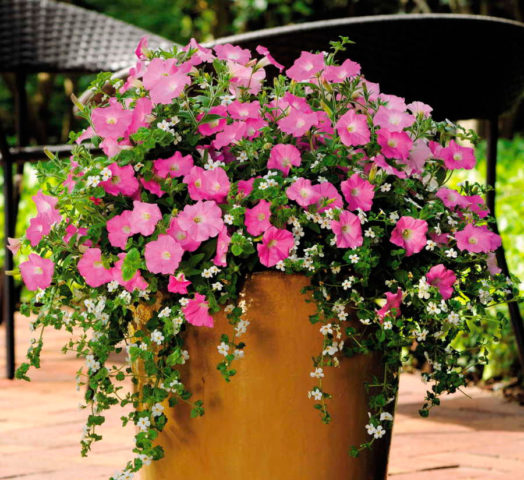
Bacopa and petunia flowers are capable of creating magically attractive sketches, from which it is impossible to take your eyes off
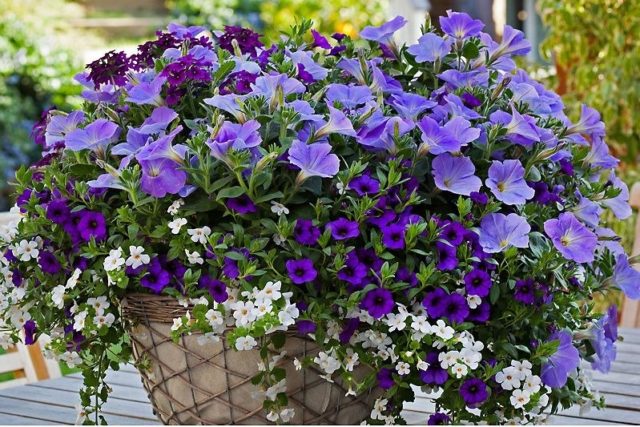
Stylish and harmonious white bacopa flowers look with different shades of purple and blue in a textured wicker basket
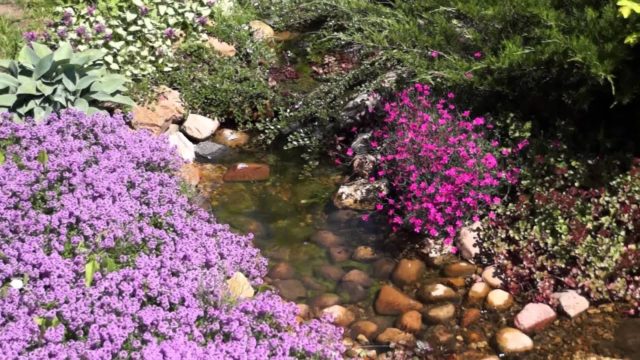
Lush "clouds" of suter flowers near artificial mini-ponds and fountains look especially romantic and sophisticated.
Conclusion
Ampel Bacopa is a gorgeous, profusely blooming ornamental culture that is overwhelmingly popular among modern landscape and interior designers. A versatile plant that takes root well in indoor conditions and in the garden.
